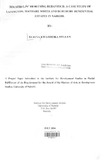| dc.description.abstract | This study examines the remitting behaviour among househelps working in Lavington,
Mathare North and Buruburu residential estates in Nairobi. The broad objective of the study
was to assess the remitting behaviour among househelps. However, there were four specific
objectives which are as follows; to establish the proportion of income remitted among
househelps, to establish the frequency of remittances among househelps, to identify the
purposes for remitting and to identify the factors that influence remittances.
This study made use of both primary and secondary sources of data. Primary data was
obtained using the following techniques; semi-structured questionnaires, interview guides,
case histories and direct observation. Secondary data was derived from books, journals,
theses, magazines and government statistical reports amongst others. Non-probabilty
sampling methods were used i.e. purposive and snowball sampling. Both quantitative and
qualitative methods were used to analyze the data. Cross tabulations and Chi-squares tests
were used to establish the relationship between the different variables.
From this study, it was established that cash remittances to households was ranged between
Kshs 500 and Kshs. 6000 with 81.7 per cent of the respondents remitting on a monthly basis.
Goods sent to households included foodstuffs and clothing whose value ranged from Kshs
400 to Kshs.3000. These goods were only purchased periodically by 46.7 per cent of the
respondents during their visits home. On average, respondents in Mathare North were
remitting 55.33 per cent of their earnings while those in Lavington and Buruburu remitted
38.l per cent and 70.68 per cent respectively Most of the remittances were channeled
towards meeting basic household needs i.e. food, clothing amongst others. However, in
areas with high agricultural potential, the money was used to give contributions towards
community groups amongst others. This study has also been able to establish that there is no
relationship between remittances and the marital status and level of education of househelps.
Based on the findings, the following recommendations have been made. There is need for
househelps to be empowered on their rights as workers. This will ensure that they are in a
position to demand for their rights more so in as far as their salary is concerned. They will
also learn the benefits of working together under the Kenya Union of Domestic, Hotels,
Educational Institutions, Hospitals and Allied Workers. This will in return ensure that the
flow of remittances is enhanced between the househelps and their families. There is also need
to find out what opportunities of saving are available for househelps. These opportunities
should be flexible and tailored to meet their needs. | en |

